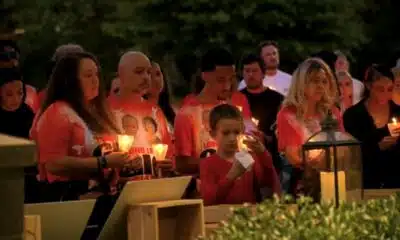News from the South - North Carolina News Feed
I-26 rest areas back in action? Big pile of dirt next to Fletcher Town Hall? Pedestrian bridge still out at Bill Moore Park? • Asheville Watchdog
Before we get to today’s round of questions, my smart-aleck replies and the real answers, allow me to wish you a happy 2025. This might well be a doozy of a year, but let’s go into it with a positive attitude.
So here’s to 2025 — may we have no more natural or man-made disasters! Sorry, that’s the best I can muster.
Now, to the questions…
Question: After Helene, the two rest areas on I-26 just south of the airport were appropriated for water trucks and other support equipment. The areas were “closed” by posting people in private vehicles 24 hours a day at the entrance to each area, and then posting cardboard, handwritten signs beside those vehicles stating that the area is closed. Who is coordinating this closure and who is paying people to sit in cars at the entrance? Why is the closure being handled in such a haphazard way, rather than having the highway department officially mark them as closed at the rest area approach signs and barricade them off? I pass these areas every day and constantly see confused motorists drive right up to these vehicles performing the closure because it is so poorly marked. Is FEMA involved in this?
My answer: I know when I’m driving a long distance and I pull onto the ramp for the rest area, I’m going to the bathroom somewhere. For you whippersnappers out there, this sense of urgency is just another gift of aging to look forward to.
Real answer: The reader has a point. The rest areas had become a little haphazard a couple of months into recovery, with less than optimal signage.
The good news is one of the rest areas is back open to the public.
“The North Carolina Department of Transportation allowed N.C. Emergency Management to use the two I-26 rest areas to stage equipment so that critical supplies could be delivered quickly during the unprecedented Helene response effort,” Brian Haines, a spokesperson for the North Carolina Department of Public Safety, told me via email. “Operations included a fuel vendor and an equipment vendor providing support to the Tropical Storm Helene response efforts. Both vendors had employees safely block any traffic from entering the rest areas.”
As local conditions have improved, Emergency Management has been able to scale back its operations, “and NCDOT was able to reopen the rest area on the westbound side” Dec. 19, Haines said.
“NCDOT will continue to evaluate the response needs and will reopen the rest area on the eastbound side as soon as possible,” Haines added.
I suspect because the usage was temporary, the state didn’t want to invest in real signs. I’ll note that the eastbound rest area remained closed Thursday, with a handmade sign on the ramp, as well as several bright orange traffic barrels.
While I was there a semi rolled up near the makeshift sign, came to a stop and then had to re-enter the highway. Not optimal, folks.


Question: Actually, I have two questions: 1) What is going on north of Bill Moore Community Park in Fletcher with the earth moving and a mountain of red earth? 2) When do the powers in charge expect to open the rest of the path going across the bridge at Bill Moore Community Park in Fletcher?
My answer: I have two snarky answers for you: 1) This is Fletcher’s latest tourist attraction, “Red Earth Mountain.” I didn’t say it’s a particularly charming attraction; it’s just one that draws attention. 2) I think we all know for certain now that the power in charge is Mother Nature, and as the old commercial for Chiffon margarine used to say, “It’s Not Nice To Fool Mother Nature!” Also, I’m officially a geezer, as that commercial dates to the 1970s. You’re welcome in advance for these types of ancient references in 2025.
Real answer: The red dirt mountain is on the site of a new housing development called “The Landing at Meadow View,” with plans calling for 216 apartments, 60 townhomes, and 23 patio homes. Apartments will range from approximately 1,000 to 1,500 square feet, townhomes from 800 to 1,400 square feet, and villas from 1,100 to 1,700 square feet, according to the development company, BSC Holdings of Greensboro.
I wrote about the project last summer when readers began taking note of substantial tree removal on site. A home dating to the 1800s remains on site with a small copse of trees around it.
Amanda Williams, vice president of BSC Holdings of Greensboro, said last summer that they hoped construction on the buildings would begin in late summer or early fall of this year, with some units coming online by mid-2026.
But Helene had other ideas. Williams said now it’s more likely to be spring or summer 2026 before construction on buildings starts. This year will be dedicated to grading and infrastructure work, mostly.
“We’ve got a bunch of dirt to still move — as you see now, we’ve got to fill the bottom,” Williams said. “We’ve got to fix all the stuff that the water impeded down below.”
The state of North Carolina essentially borrowed BSC’s earthmoving contractor to help repair roads and other infrastructure in the wake of Helene. Williams said BSC hopes to have the contractor back on the Fletcher project near the end of this month.
The plans remain essentially the same, although Williams said they may lose three or four units on the bottom area because they’ll add even more fill dirt in the area now. Even before the flood, BSC had planned to raise the area up several feet above the town’s requirements, but now the company plans to go even higher.
“We’re talking about being seven or eight feet above,” Williams said.
Fletcher voted in December to establish a 12-month moratorium for any new proposed development within floodplains, but the Landing at Meadow View is grandfathered in. Williams said company officials visited the area about three weeks after the storm, including a stop by apartments next to Bill Moore Community Park that flooded, and decided their development would need to be higher.
Williams maintains their development should not contribute to more flooding downstream, as BSC will build up only around the buildings, and they have about 30 acres along Cane Creek that will not be developed.

“Our build-up area is only going to be where the actual buildings are and around them and where the roads are,” Williams said. “So we’re not going to be building up the whole flood area. We’re literally going to be building up — think about this like a bubble around the developed area. So there’ll still be a ton of what’s natural area.”
Eric Rufa, planning director for the Town of Fletcher, noted that the project initially was approved in 2019.
“They started earthwork last summer and are now delayed due to Helene,” Rufa said. “Some portion of the development is to be in floodplain, but the homes sites will be elevated. In the wake of Helene, the developer is also reconsidering higher elevations than required. I do not have a timeline on when they will resume work.”
Williams said if they can get the contractor back on site and the weather holds, passersby should start seeing the big red mounds start to slowly disappear this winter.
Williams told me last summer the project’s holdup from 2019 revolved mostly around permitting, as the site is near a creek and a wetland and needed approvals from the U.S. Army Corps of Engineers, and the North Carolina Department of Natural and Cultural Resources. Those permits still remain in place, Williams said.
Now, regarding the pedestrian bridge. This part of the trail system in Bill Moore Park is a popular path, which I can attest to as a fairly frequent user.
But Cane Creek, which passes underneath this bridge, became a destructive demon during the Helene flooding.
“On the outer greenway trail question, the reason why it is technically closed is due to the bridge needing repairs,” Fletcher Town Manager Mark Biberdorf told me via email. “You cannot really see it from the closed side, but the bridge is not fully connected on the opposite side. The amount and force of the water caused the bank to partially wash out where it connects to the bridge.”
The metal pedestrian bridge has a concrete deck and is pretty sturdy, so that says something about Helene’s power.
“The town is currently working with its engineering firm to bid out repairs to the bridge,” Biberdorf said. “It will be several more months before that process will be completed. It involves partial FEMA reimbursement for the expenses, which complicates things.”
Asheville Watchdog is a nonprofit news team producing stories that matter to Asheville and Buncombe County. Got a question? Send it to John Boyle at jboyle@avlwatchdog.org or 828-337-0941. His Answer Man columns appear each Tuesday and Friday. The Watchdog’s reporting is made possible by donations from the community. To show your support for this vital public service go to avlwatchdog.org/support-our-publication/.
Related
The post I-26 rest areas back in action? Big pile of dirt next to Fletcher Town Hall? Pedestrian bridge still out at Bill Moore Park? • Asheville Watchdog appeared first on avlwatchdog.org
News from the South - North Carolina News Feed
White House officials hold prayer vigil for Charlie Kirk
SUMMARY: Republican lawmakers, conservative leaders, and Trump administration officials held a prayer vigil and memorial at the Kennedy Center honoring slain activist Charlie Kirk, founder of Turning Point USA. Kirk was killed in Utah, where memorials continue at Utah Valley University and Turning Point USA’s headquarters. Police say 22-year-old Tyler Robinson turned himself in but has not confessed or cooperated. Robinson’s roommate, his boyfriend who is transitioning, is cooperating with authorities. Investigators are examining messages Robinson allegedly sent on Discord joking about the shooting. Robinson faces charges including aggravated murder, obstruction of justice, and felony firearm discharge.
White House officials and Republican lawmakers gathered at the Kennedy Center at 6 p.m. to hold a prayer vigil in remembrance of conservative activist Charlie Kirk.
https://abc11.com/us-world/
Download: https://abc11.com/apps/
Like us on Facebook: https://www.facebook.com/ABC11/
Instagram: https://www.instagram.com/abc11_wtvd/
Threads: https://www.threads.net/@abc11_wtvd
TIKTOK: https://www.tiktok.com/@abc11_eyewitnessnews
News from the South - North Carolina News Feed
Family, friends hold candlelight vigil in honor of Giovanni Pelletier
SUMMARY: Family and friends held a candlelight vigil in Apex to honor Giovanni Pelletier, a Fuquay Varina High School graduate whose body was found last month in a Florida retention pond. Giovanni went missing while visiting family, after reportedly acting erratically and leaving his cousins’ car. Loved ones remembered his infectious smile, laughter, and loyal friendship, expressing how deeply he impacted their lives. His mother shared the family’s ongoing grief and search for answers as authorities continue investigating his death. Despite the sadness, the community’s support has provided comfort. A celebration of life mass is planned in Apex to further commemorate Giovanni’s memory.
“It’s good to know how loved someone is in their community.”
More: https://abc11.com/post/giovanni-pelletier-family-friends-hold-candlelight-vigil-honor-wake-teen-found-dead-florida/17811995/
Download: https://abc11.com/apps/
Like us on Facebook: https://www.facebook.com/ABC11/
Instagram: https://www.instagram.com/abc11_wtvd/
Threads: https://www.threads.net/@abc11_wtvd
TIKTOK: https://www.tiktok.com/@abc11_eyewitnessnews
News from the South - North Carolina News Feed
NC Courage wins 2-1 against Angel City FC
SUMMARY: The North Carolina Courage defeated Angel City FC 2-1 in Cary, ending their unbeaten streak. Monaca scored early at the 6th minute, followed by Bull City native Brianna Pinto’s goal at the 18th minute, securing a 2-0 halftime lead. Angel City intensified in the second half, scoring in the 88th minute, but the Courage held firm defensively to claim victory. Pinto expressed pride in the win, emphasizing the team’s unity and playoff ambitions. Nearly 8,000 fans attended. Coverage continues tonight at 11, alongside college football updates, including the Tar Heels vs. Richmond game live from Chapel Hill.
Saturday’s win was crucial for the Courage as the regular season starts to wind down.
https://abc11.com/post/north-carolina-courage-wins-2-1-angel-city-fc/17810234/
Download: https://abc11.com/apps/
Like us on Facebook: https://www.facebook.com/ABC11/
Instagram: https://www.instagram.com/abc11_wtvd/
Threads: https://www.threads.net/@abc11_wtvd
TIKTOK: https://www.tiktok.com/@abc11_eyewitnessnews
-
News from the South - North Carolina News Feed6 days ago
What we know about Charlie Kirk shooting suspect, how he was caught
-
News from the South - North Carolina News Feed6 days ago
Federal hate crime charge sought in Charlotte stabbing | North Carolina
-
Our Mississippi Home5 days ago
Screech Owls – Small but Cute
-
News from the South - Arkansas News Feed6 days ago
NW Arkansas Championship expected to bring money to Rogers
-
News from the South - North Carolina News Feed7 days ago
Under pressure, some immigrants are leaving American dreams behind
-
News from the South - Texas News Feed6 days ago
Safe Central Texas meet-up spots for online purchases
-
Mississippi News Video6 days ago
Mississippi Science Fest showcases STEAM events, activities
-
News from the South - Tennessee News Feed6 days ago
What to know about Trump’s National Guard deployment to Memphis
















































